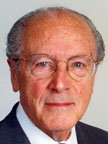|

Dean
Dominick Purpura: Breaking Down Barriers at Albert Einstein
By
JOAN BAUM, PH.D.
An
almost life-size sculpture of Albert Einstein, with his hands
folded and legs crossed, looks over Dr. Dominick P. Purpura, Dean
of Albert Einstein College of Medicine of Yeshiva University (AECOM),
when he is in his office. The sculpture is certainly a fitting
touch.
Purpura, a celebrated, world-class neuroscientist and the longest-serving
medical school dean in the country, pursues his agenda with an
ethical passion and a sense of humor in the tradition of the school’s
spiritual mentor. In highlighting the “small-group, student-centered
problem-based learning” he has instituted at AECOM, Purpura invokes
Socrates, whose dialogic method encouraged students to ask questions
and think for themselves.
“The
brain is a problem solver, not a sponge,” he says.
Generous in his acknowledgment of colleagues, both at the medical
school and in AECOM’s affiliate hospitals, the Dean, who is also
Vice President for Medical Affairs of Yeshiva University, knows
exactly what he has helped change in medical education at AECOM,
and why. His overall plan in curricular reform over the last few
years has been the integration of what used to be the separate
study of cellular biology, genetics, and pathology, for example,
and the institution of interdisciplinary courses “relevant to
the human condition in health and disease.”
Some years ago AECOM reorganized the “atavistic” model of medical
school education based on self-contained subject matter classes,
large lectures and basic science concentrated in the first two
years, clinical only in the last two. Now both interdisciplinary
megacourses and small, problem-solving based courses in the Education,
Clinical and Research divisions define the curriculum.
And while Einstein continues to advance what it is best known
for, biomedical research, a lot more attention is being paid to
mentoring, career counseling, emergency medicine, ethics and preclinical
clerkships. Associate Dean Dr. Deborah S. Kligler, a sociologist,
notes that women now constitute 52 percent of the entering class
of 180, a fact that, influenced AECOM’s greater attention to societal
issues, reflected in programs such as Family Life, in which all
medical students track a family for four years. There’s a “healthquake”
going on out there, says the Dean, proud of his new coinage.
Seventy percent of the students in the entering class are given
summer grants to work in labs, start on graduation projects in
community health service and develop an early appreciation of
clinical medicine.
Other success factors include faculty development, pre-clinical
clerkships and program evaluations, as well as the continuing
restructuring of the curriculum, which the Dean refers to with
a wink as “the continuing magnificent obsession of the faculty.”
But, he does have concerns. Requiring students to look at a problem
“in terms of its molecular, cellular, systemic, behavioral and
epidemiological as well as socioeconomic and ethical components,
in the same setting” is labor intensive. But he will not back
down.
The research process, Evidence-Based Medicine, needs teachers
to be academic mentors and career counselors as early as the students’
first years. This need, along with the greater work involved in
the labor-intensive curriculum, has resulted in a much greater
dedication of the faculty, closer cooperation among faculty in
different disciplines and between AECOM and its affiliate hospitals.
Another one of Purpura’s concerns relates to these hospitals.
He is tenacious in trying to break down the firewall between medical
schools and their teaching hospitals, a barrier related to patient
confidentiality.
Curricular reorganization at AECOM has meant that residents, who
perform 60 percent of medical school teaching, and who are already
working at a high patient volume, are now doing more teaching
and at an earlier point in the medical school curriculum.
Einstein, it should be noted, also enrolls approximately 10 to
12 percent of its students in its MD/Ph.D. program, the second
oldest in the nation. While Primary Medicine, Pediatrics, Internal
Medicine and Ob/Gyn still attract 41 percent of those students
declaring specialties, an increasing number of Einstein graduates
select to specialize in neurobiology and psychiatry.
Education Update, Inc., P.O. Box 20005, New York, NY 10001. Tel:
(212) 481-5519. Fax: (212) 481-3919. Email: ednews1@aol.com.
All material is copyrighted and may not be printed without express consent of
the publisher. © 2001.
|

